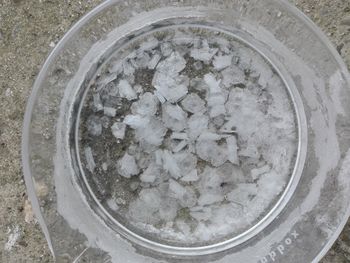Difference between revisions of "Crystallizing dish"
(Created page with "{{Stub}} A '''crystallizing dish''' is a beaker with a very large diameter and short height. Its large surface allows for the solution to evaporate faster, which is necess...") |
(→General) |
||
| (4 intermediate revisions by the same user not shown) | |||
| Line 1: | Line 1: | ||
{{Stub}} | {{Stub}} | ||
| + | [[File:Ammonium perchlorate crystals.jpg|thumb|350px|A crystallizing dish with [[ammonium perchlorate]].]] | ||
A '''crystallizing dish''' is a [[beaker]] with a very large diameter and short height. Its large surface allows for the solution to evaporate faster, which is necessary when recrystallizing compounds, hence its name. | A '''crystallizing dish''' is a [[beaker]] with a very large diameter and short height. Its large surface allows for the solution to evaporate faster, which is necessary when recrystallizing compounds, hence its name. | ||
| + | |||
| + | While similar to [[evaporating dish]]es, the crystallizing dish is not generally used to completely evaporate the solution. | ||
==General== | ==General== | ||
| − | The crystallizing dish is basically a flat [[beaker]], with a spout. It is made of borosilicate glass, | + | The crystallizing dish is basically a short and flat [[beaker]], with or without a spout. Comes in two varieties, thin walled and thick walled. It is made of borosilicate glass, though plastic and porcelain crystallizing dishes are available, though they're rarely used. Metal vessels are generally not recommended to be used, since there is a risk of contaminating of the final product, especially during the process of scrapping off the crystals. |
==Availability== | ==Availability== | ||
Crystallizing dishes can be bought from lab suppliers or online. | Crystallizing dishes can be bought from lab suppliers or online. | ||
| + | |||
| + | ==Alternatives== | ||
| + | Glass baking dishes, used in kitchen for cooking, can be used as a replacement for the crystallizing dish. | ||
| + | |||
| + | In general, any vessel with a flat and smooth inner surface, with no inner sharp edges, be it made out of glass, ceramic or plastic, can be used as crystallizing dish. Avoid any vessels that have their brand printed on the inner surface, as this can and will interfere with the recrystallization process, and is not easy to clean. | ||
==Projects== | ==Projects== | ||
| Line 13: | Line 21: | ||
==See also== | ==See also== | ||
*[[Beaker]] | *[[Beaker]] | ||
| + | *[[Evaporating dish]] | ||
*[[Petri dish]] | *[[Petri dish]] | ||
*[[Watch glass]] | *[[Watch glass]] | ||
| Line 19: | Line 28: | ||
<references/> | <references/> | ||
===Relevant Sciencemadness threads=== | ===Relevant Sciencemadness threads=== | ||
| + | *[http://www.sciencemadness.org/talk/viewthread.php?tid=77542 Possible Uses for Broken Glassware] | ||
[[Category:Lab equipment]] | [[Category:Lab equipment]] | ||
[[Category:Glassware]] | [[Category:Glassware]] | ||
| + | [[Category:Plasticware]] | ||
| + | [[Category:Ceramicware]] | ||
Latest revision as of 16:19, 26 February 2023
 |
This article is a stub. Please help Sciencemadness Wiki by expanding it, adding pictures, and improving existing text.
|

A crystallizing dish is a beaker with a very large diameter and short height. Its large surface allows for the solution to evaporate faster, which is necessary when recrystallizing compounds, hence its name.
While similar to evaporating dishes, the crystallizing dish is not generally used to completely evaporate the solution.
Contents
General
The crystallizing dish is basically a short and flat beaker, with or without a spout. Comes in two varieties, thin walled and thick walled. It is made of borosilicate glass, though plastic and porcelain crystallizing dishes are available, though they're rarely used. Metal vessels are generally not recommended to be used, since there is a risk of contaminating of the final product, especially during the process of scrapping off the crystals.
Availability
Crystallizing dishes can be bought from lab suppliers or online.
Alternatives
Glass baking dishes, used in kitchen for cooking, can be used as a replacement for the crystallizing dish.
In general, any vessel with a flat and smooth inner surface, with no inner sharp edges, be it made out of glass, ceramic or plastic, can be used as crystallizing dish. Avoid any vessels that have their brand printed on the inner surface, as this can and will interfere with the recrystallization process, and is not easy to clean.
Projects
- Grow crystals